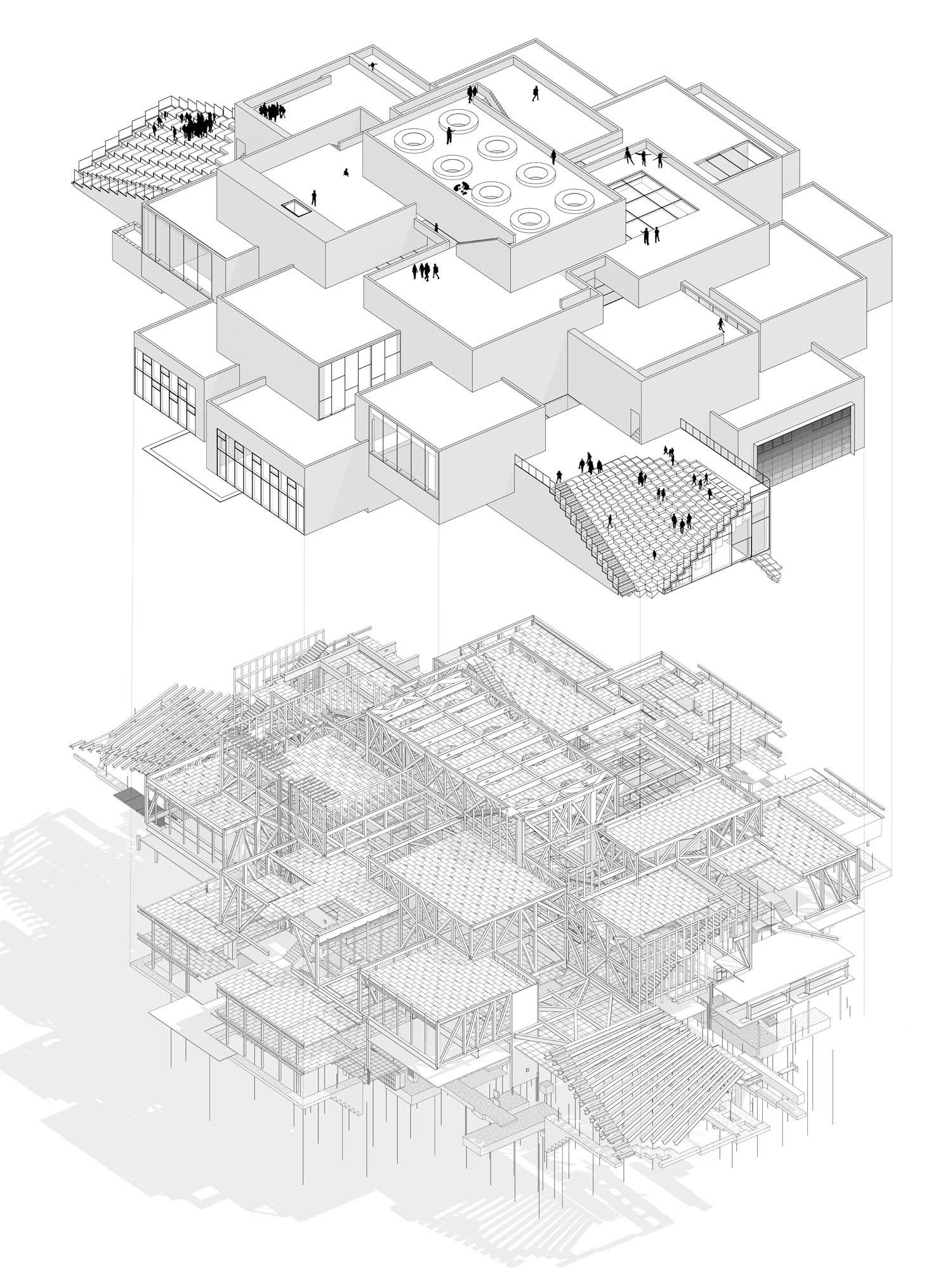BIG-style BIM: interview with Jens Majdal Kaarsholm
Jens Majdal Kaarsholm, BIM Manager at Danish ‘starchitect’ firm BIG, talks Revit skills, industry standards and leadership styles and offers his advice for firms just starting out on their own BIM journeys
BIG (Bjarke Ingels Group) is a world-renowned Danish architectural practice, internationally recognised for its pioneering, – bold and innovative exploration of architectural boundaries.
The company’s exclusive status as an international ‘starchitect’ practice attracts clients from across the world, who are willing to entrust the company with a great level of creative freedom and significant budgets, in return for state-of-the-art architecture.
With such great expectations, there follows a massive commitment to ensure that each and every building becomes a defining landmark for both the client and the environment it inhabits.
It is exactly this creative and complex variation between projects that make starchitect practices like BIG so intriguing to study. Every unique design demands a unique approach and strategy, which also translates into BIM development.
When we talk about automation and optimisation in a BIM-related context, the typical idea is that the more we can repeat and standardise across projects, the more we can take advantage of BIM. But what about firms like BIG that work on projects that are not remotely similar or repetitive in nature? What strategies do they have for BIM?

There is probably no better person to ask than Jens Majdal Kaarsholm, who has built an impressive career around establishing such systems in his current role as BIM Manager at BIG and his previous role as BIM Manager at Foster + Partners.
Throughout his career, Kaarsholm has led the digital design of some of the most prestigious and complex building projects built in modern times.
Today, Kaarsholm oversees all BIM projects on a day-to-day level at the BIG headquarters in Copenhagen, Denmark, while also supporting the offices in London & Barcelona.
He has left his modelling days behind him, as is the case for many BIM managers in larger practices, where the role is strictly confined to managing company standards, training staff, and providing project consultation and support.
Since returning to Denmark in 2018, Kaarsholm has taken a great personal interest in enabling the overall industry advancement of BIM domestically. Through his active engagement as a group user of MOLIO (Danish Building Research Establishment & buildingSMART) and the Digital Task Force at Danske ARK (Danish Association of Architectural Firms), he has become an essential voice of the industry and a trusted BIM advisor to both the private and public sector.
I am enthusiastically – if not impatiently – waiting for the next groundbreaking modelling tool to sweep me off my feet. I’m putting my money on the young innovators and entrepreneurs, just like the small team of German enthusiasts who seemingly out of nowhere released an inexpensive and ingenious plug-in for Revit, which would go on to redefine the whole field of architectural rendering – namely, Enscape
Danish newspaper Berlingske recently shortlisted him as one of the Top 100 Young Talents in Denmark, in recognition of both his career achievements and volunteering efforts.
Kaarsholm’s wide engagement with the industry, both domestically and internationally has won him a strong international reputation that comes with its own responsibilities. “There is not a day where the thought of leaving this industry for good and perhaps becoming a gardener instead does not strike me,” he jokes.
At the headquarters of Foster + Partners in London, Kaarsholm was one of the key figures in leading the company’s transition to Revit. As BIM Operations Manager, he oversaw all global BIM projects and led a team of 28 BIM coordinators. It’s a role and a transition that he would go on to successfully repeat at BIG.
Mastering Revit
Mastering Revit has been a big aspect of his career, says Kaarsholm. “I was a part of probably the first wave of students in Denmark, who were being taught extensively in Revit, and I graduated straight into an industry that was ripe for the transition to BIM. That was back in 2012. Everyone wanted BIM and most associated BIM with Revit at the time. Therefore, it became the obvious career path for me, to specialise in Autodesk’s ecosystem.”


But despite having clearly benefited from his expertise in Revit, Kaarsholm by no means considers himself a Revit ‘fanboy’ or a sworn Autodesk devotee. For example, he supports the ‘open letter initiative’ of July 2020, which saw many highly regarded design firms come together to express their frustration with the direction Autodesk is taking. Their main criticism was the company’s transition to subscription-based licensing, resulting in increased costs for customers, and what they see as the unsatisfactorily slow development of Revit. The open letter spread like wildfire on social media, forcing Autodesk CEO Andrew Anagnost to respond in defence of the company, via a blog post published in August 2020 on the company’s website.
Says Kaarsholm: “I think the open letter reflects very well on the current frustration that is experienced, particularly within the architectural discipline, regarding Revit not being developed at a satisfactory pace, and in accordance with the industry needs and wants.”
At the same time, he believes the same criticism applies equally to competing BIM applications. “Each of these applications provides more or less the same services and features, with a few – mostly minor – variations, which ultimately make up the pros and cons of each software, while stirring up a heck of debate among devoted users.”
I think the open letter reflects very well on the current frustration that is experienced, particularly within the architectural discipline, regarding Revit not being developed at a satisfactory pace, and in accordance with the industry needs and wants. With that being said, I believe the same applies to competing BIM authoring applications currently available on the market
With that in mind, he sees absolutely no reason to switch from his application of choice, until something entirely new and game changing disrupts the industry. He does, however, look forward to that day, he says, as it has become clear that most modelling programmes do not deliver the fresh breath of innovation they once did.
“I am enthusiastically – if not impatiently – waiting for the next groundbreaking modelling tool to sweep me off my feet. I’m putting my money on the young innovators and entrepreneurs, just like the small team of German enthusiasts who seemingly out of nowhere released an inexpensive and ingenious plug-in for Revit, which would go on to redefine the whole field of architectural rendering – namely, Enscape.”
Setting standards straight
The debate on BIM standards, templates and data exchanges has been raging for decades. Having that debate is not without its merits, however, because the issue of standards is incredibly complicated and one on which expert opinion varies widely.
“At BIG, we have one goal and one commitment that ranks above all others. I always make that very clear. That goal is to design incredible buildings. There is no exception. The aim should always be to implement BIM without hindering the design process,” says Kaarsholm.
“As the practice BIM Manager, it is my job and responsibility to ensure that our BIM system is tailored to provide the designers with the right tools, workflows and conditions to optimally support their core function, which is to design great buildings and deliver useful digital assets to our clients.”
The trick is to implement just the right amount of technology to efficiently support designers, he says, without “overwhelming and exhausting” them. It’s often the case with BIM that less is more, because the availability of tools, plug-ins, scripts and templates, although fantastic, can also be overwhelming.

So what roles does he believe automation and programming should play in BIM? Automation is a topic with which much of the industry is flirting right now, as is the team at BIG, he acknowledges. “But I pay careful attention to ensure that all automation initiatives are thoroughly assessed and evaluated before proceeding with any development or implementation. The value of automation is obviously undisputable, but sometimes people tend to get so lost in trying to do everything better, that they fail to do it at all, or find themselves spending longer time writing up scripts than it takes to do the job manually.”
Increased model complexity may unlock more benefits from BIM, but Kaarsholm observes that the more advanced BIM models become, the more fragile they get. “If you go to any BIM conference these days, everyone seems to be in a race to flash their fanciest renders and most complex scripts, while most avoid showcasing the actual quality of the digital assets that hide underneath the makeup, and those assets are what matter in the end. They are the true value of the BIM model. In my opinion, we must watch out for this flirtation with optimisation not becoming blind love.”
At BIG we have one goal ‘‘ and one commitment which ranks above all others. I always make that very clear. That goal is to design incredible buildings. There is no exception, the aim should always be to implement BIM without hindering the design process
That said, there is almost certainly a time and a place for allocating resources to optimising workflows, he adds, and it’s something he looks forward to with excitement.
“More advanced workflows, such as visual programming and scripting, allow us to further explore, analyse and innovate architecture and furthermore increase both project speed, accuracy, and quality. But as strong as advanced workflows may be in the hands of the experts, as fragile they can be in the wrong hands. The more dependent BIM projects become on these workflows, the more reliant the projects become on the very few individuals who possess the appropriate skills and know-how.”
On the subject of skills, he feels it’s not just a case of upskilling employees. Anybody who has worked as a BIM manager, he says, knows that it is a time-consuming and difficult task. Plus, it’s the young graduates who know how to code, an advantage that gives them a greater edge to enter the workforce, but can also put projects at risk of failure if they are not supervised. At the other end of the spectrum, established BIM expertise continues to be in high demand and short supply, which means that available talent tends to hop between practices.
Modelling and managing
As someone who has led and trained many BIM coordinators and managers, Kaarsholm has witnessed several situations where projects were put on hold for days because crucial elements of the BIM model were heavily reliant on scripting. That meant they could only be manipulated by employees who were unavailable at the time.
“I also continue to see BIM objects that are so advanced and parametrically constrained that no one except the creator can figure out how to use them,” he says. That can have detrimental effects on BIM model health, deadlines and employee satisfaction – but these consequences are often overshadowed by the vast automation hype.
“Therefore, it is crucial to assess the need for increased model complexity with utmost consideration and care, to minimise unpredictable disruptions and too much expert dependency. It is, for instance, sometimes the case that doing some tasks manually is both faster, easier, and safer than trying to automate them. That being said, I want to make clear that we are strong supporters of automation and scripting at BIG. Due to the complex nature of many of our designs, I believe many projects would have never been realised without these technologies and workflows at hand. Therefore, we allocate vast resources into researching cutting-edge tools and workflows – but we evaluate and implement with care and maintain a rule in the office that no script should depend on just one person.”

The role of BIM managers, he adds, is still widely misunderstood. While they should certainly possess a high level of knowledge of the applications, standards, contents and workflows associated with a company’s BIM system, mastering software and tools isn’t synonymous with being a good BIM manager, he says. Great communications skills, teaching abilities and project management skills still count for more than software prowess.
Kaarsholm doesn’t consider himself a scripting wizard, for example. “In fact, my head is simply not geared for complex scripting.” But he’s good at assessing project scope and breaking down projects into realistic deliverables, and at sorting ‘musthaves’ from ‘nice to haves’. And being of an optimistic mindset, he can approach challenges with a confidence and positive attitude that permeates his team.
He also sets clear boundaries. “I usually object to proceeding with any development on a project until everybody on the project team – external and internal – has agreed on a shared strategy for aligning BIM deliverables. This is the part that I am most strict about. It is important to make these deliverables completely transparent to everybody involved – especially the client and contractors. Far too many times in the past, I’ve witnessed the consequences of clients and contractors being improperly advised to request BIM deliverables that exceeded both their demands and expectations. Therefore, I try to insist on clearly outlining the project requirements together with clients before kickstarting a project.”
At the end of the day, he believes, digital deliverables are produced for and on behalf of the client, who expects at the end to receive a project in the end that reflects their requirements for the digital assets. “So BIM deliverables should never be overshadowed by a perceived desire to ‘do better BIM’, unless everyone has agreed to pursue a more ambitious BIM scope.”
Standard issue: Where next for PAS, BSI, ISO, IFC et al?
In Denmark, the AEC industry has worked effectively with widelyadopted national BIM standards for more than a decade, according to Jens Majdal Kaarsholm, and workflows that evolved around IFC deliverables have been more or less cemented into many practices since the first national BIM mandate for IFS in 2007.
During his time at Foster + Partners, moreover, Kaarsholm became more engaged with PAS-1192 standards (since succeeded by ISO-19650), which he also found to be a robust set of standards.
But he offers a caveat to all this: Some standards can be too robust and overly complicated. “Most standards are generally great standards, if only everybody can agree on using them. Obviously, this is where tricky reality kicks in.”
The UK, for example, has gone to great efforts to ensure that its national PAS and BSI BIM standards became new international standards, and the ISO-series offers a comprehensive approach to standardise “absolutely everything, down to the smallest level of detail,” he says.
This could be a bottleneck on some projects where requirements for digital assets are still low. “We must accept that many clients are still not there yet, and do not want to invest in it. If clients do not see the benefit of investing in data-rich digital assets, I do not see the reason to chuck it down their throats for the sake of satisfying an undesired ambition.”
Regarding IFC, his view is mixed. “If there’s one thing that IFC has historically struggled with, it is correctly exporting complex geometry from authoring programmes like Revit,” he says.
Since complex geometry has been one of the defining factors of many projects that he has worked on, that has been a point of frustration. Fortunately, he’s seen great improvements to address the conversion issue with the recent release of the IFC4 schema, which supersedes the widely adopted IFC2x3 schema – but most of the industry has not yet transitioned to IFC4.
“Besides that, IFC is unquestionably slow at times, which can be a real pain,” he adds. “I would be lying if I said that it does not make my life a lot easier when everybody just works in Revit. But that is not to say that I am opposed to openBIM. In fact, I strongly support the overall ethos of openBIM. I believe that the longevity, reliability, and quality of a set of IFC data assets make a much more desirable building asset model (BAM) for the operational phase than proprietary formats.”
Final words of advice
So, drawing on his years of experience, what guidance would Jens Majdal Kaarsholm offer to firms struggling to adopt BIM successfully in their own projects? He has four pieces of advice:
1) Accept the bumps – they will diminish, but never disappear entirely
“BIM will be a continuously bumpy ride. Even at BIG, we cannot avoid these occasional bumps on the road, and that is despite us having invested in establishing strong company standards and hiring plenty of experts to see the standards through. Project variables are simply too many and the BIM scene is changing so rapidly. But I think it is also important to understand that many of these newfound ‘bumps’ are often mistaken for being a direct consequence of ‘complicated technology’, when in reality, they are a consequence of traditional workflow inefficiencies and inaccuracies being revealed and thus revised early on in the BIM process.”
2) Don’t underestimate the power of communication
“In my opinion, the number one obstacle to successful project BIM implementation can be traced back to the initial conversation with the client and the contractor. Even in Denmark, where BIM has been strongly promoted by the government and designers since 2007, we still struggle immensely with clients lacking BIM know-how. They simply do not know what to expect, what to ask or how to utilise the BIM assets that they request us to develop for them. As a result, they are prone to ask for much more than they actually need, while also being easily swayed – typically by external BIM consultants – to request BIM deliverables that exceed their needs. This very pressing issue is the key reason why I have decided to become heavily engaged with the industry on an advisory level. I want to consult and teach the people in charge of making the decisions, to make the right decisions for themselves and for us.”
3) Differentiate between BIM managers, BIM experts and designers
“I have too often come across BIM managers who possess tremendous technology skills but who lack understanding and experience in assessing required project deliverables. Sometimes, these managers trap themselves in their own competency, by configuring BIM systems that represent their own level of expertise, rather than developing systems that reflect the level of expertise of the firm. It is vital as a BIM manager to always prioritise the needs and wants of the firm and to ensure that everybody is on track before taking things to the next level. It is more desirable to manage employees who are working comfortably, confidently, and synchronically on BIM deliverables that match their level of expertise, than overwhelming designers with advanced workflows prematurely. The more overwhelming the BIM system becomes, the more stressed and anxious designers tend to get, which will ultimately disrupt their ability to perform their core function, which is to design incredible buildings on tight deadlines. Anxiety and BIM is not a match made in heaven, so I recommend gradually advancing the BIM system in line with employee skills and confidence.”
4) Establish basic company standards before you start modelling
“My recommendation to new firms adopting BIM is to really conduct a thorough preliminary study on BIM standards. Before you even open your BIM tool of choice, make a list of everything you want to achieve with BIM. Agree on a firm-wide set of drawing standards and symbols upfront.
Use these as references for configuring BIM templates. Also, define how you want different building elements and objects to be represented in 2D and 3D before you start modelling them. Ensure all standard building elements are sketched out by experienced architects/technologists and do not rely on BIM-savvy graduates to make decisions about crucial library objects, template settings or modelling without giving them proper feedback and supervision. These graduates often possess amazing software abilities and passion, but they lack experience and make many mistakes, as is expected.
If you do not consider company standards from the get-go, it can become a painstakingly difficult task to implement retrospectively. Hold back from overcomplicating BIM systems and deliverables before you truly understand the implications.”
This article is adapted with permission from an interview that first appeared in Building Smart Korea, Autumn 2021 (Vol. 24) edition.
The post BIG-style BIM: interview with Jens Majdal Kaarsholm appeared first on AEC Magazine.
Powered by WPeMatico
